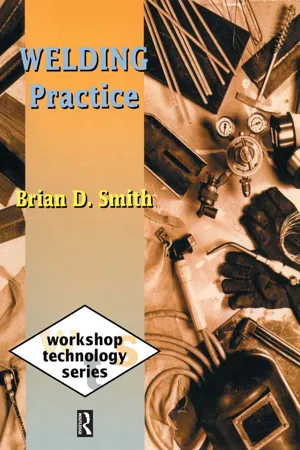![]()
1
Underpinning information
Arc welding safety
Under the Health and Safety at Work Act 1974 welders have a responsibility to take reasonable care for their safety and that of others by cooperating with safety requirements. Welding and the welding environment can create many hazards, but can be carried out quite safely if you play your part and observe some basic safety rules. There are a number of factors to be considered; a few of these are listed below.
Personal protection
Personal protection for the welder is most important, apart from the most obvious dangers of burns, stray sparks and falling objects, the arc gives off ultraviolet and infrared rays. These will affect the skin and eyes much in the same way as long periods of exposure to the sun. Suitable protection must be worn at all times to guard against these and other dangerous occurrences.
Protective clothing comes in the form of gauntlets, leather coats, aprons, sleeves, spats and capes.
The eyes should always be protected by a shade of filter glass suitable for the welding operation and amperage being used, or a clear glass for the chipping of slag. Table 1.1 details the recommended filter glasses.
Protection for the feet in the form of safety boots with a toecap is an essential part of the welder's protective clothing. Boots protect the toes from damage by falling objects, while also giving the best protection against sparks entering the footwear. Some boots have a flap up the front, others may be one piece with high legs giving good protection to the foot and leg. Low shoes or trainers are not the ideal footwear for the welder.
Table 1.1 Recommended filter glasses for welding
| Filter glasses for manual metal arc welding |
| 8-9 | EWF | up to 100 amps |
| 10-11 | EWF | 100-300 amps |
| 12-13-14 | EWF | over 300 amps |
| Filter glasses for oxyfuel gas welding: |
| 3 | GWF | Aluminium and alloys |
| 4 | GWF | Brazing and bronzing welding |
| 5 | GWF | Copper and alloys |
| 6 | GWF | Thick plate and pipe |
Filter glasses are usually protected on the outside by a separate, dear plastic cover lens. This will give protection from spatter particles and prolong the life of the filter lens.
Many types of eye protection are available in the form of spectacles, goggles, face visors, clear glasses for use with welding helmets/ shields, etc. The most important aspect when choosing any form of eye protection is that it must conform to British Standard (BS)2092. Eye protection must be worn for an cutting, grinding, chipping and welding operations.
Working at heights
In your profession as a welder it is possible that you may have to work off scaffolding, trestles, elevated platforms and so on. In most instances these elevated platforms will be erected or operated by qualified people eliminating the possible risk of collapse.
As a welder working from such platforms, extra care must be taken to avoid even the slightest risk of electric shock. Although the effects of the shock may be dismissed, it could lead to loss of balance and falling with serious or fatal results.
Remember always take extra care when working at heights.
Responsibilities of the welder
Under the Health and Safety at Work Act 1974, individuals are held responsible for their own safety as well as that of colleagues and those working in close proximity.
Always ensure you have taken all reasonable, practical precautions to avoid the risk of accidents and fires, for example:
a)good housekeeping; keep a tidy work area
b)wear protective clothing on feet, body and eyes
c)screening of workstation to protect passers-by
d)use and position extraction equipment correctly
e)carry out safety checks on equipment
f)do not tamper with safety posters or signs.
These are just a few points to consider before work commences. How many more can you think of?
Welding fumes
Welding fumes are virtually impossible to eliminate from the welding process. However, fumes can be rendered harmless by observing the following simple rules:
a)the welder positioning him/herself out of the fume path
b)using adequate ventilation either natural or mechanical - fans and extraction equipment, for instance
c)correct positioning of source of ventilationsome gases are heavier than air and will sink to the bottom of a confined area; in these cases extraction should be at a low level
d)placing the source of extraction as dose to the point of welding as possible without disturbing the gas shield
e)siting the source of extraction to pun the fumes away from the welder.
f)avoid welding on contaminated surfaces, such as oil, grease, paint, galvanised metal, etc.
Remember, fumes which include poisonous gases which asphyxiate are not always visible. Where it is not possible to use the above methods, then breathing apparatus may be required, supplied either from an airline or a personal body pack.
If in doubt ask!
Storage and handling of gas cylinders
The most common method of supplying gases used for welding is from cylinders. AH gas cylinders should be treated with respect, handled carefully and stored in well-ventilated conditions. Never allow cylinders to come into contact with heat, contaminants containing oil and grease, and observe the following handling and storage conditions:
a)always keep cylinders, fittings and connections free from oil and grease
b)store cylinders upright
c)t...
